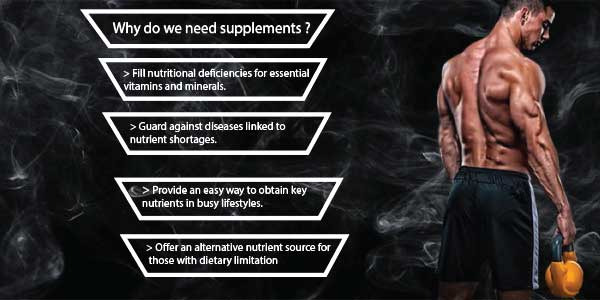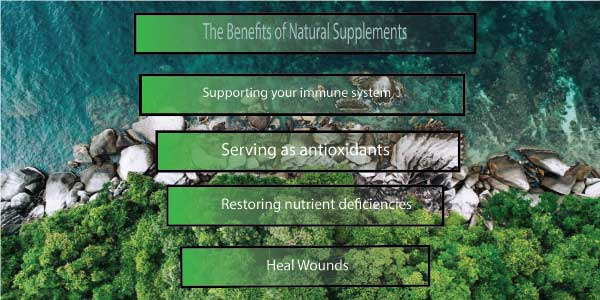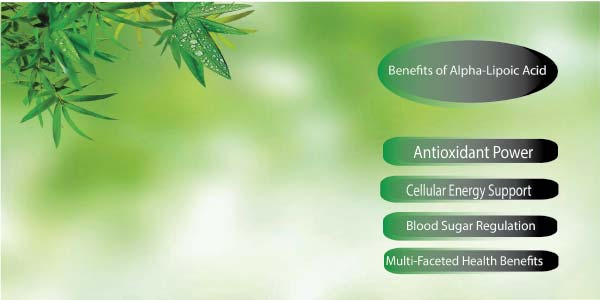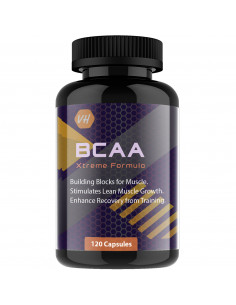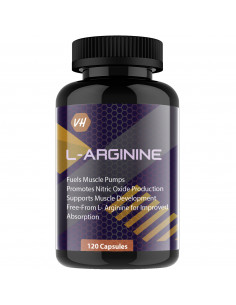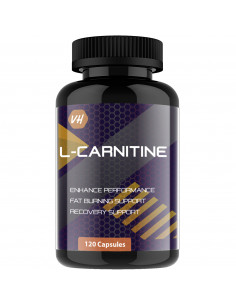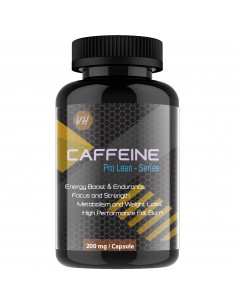- Supplement
- 4 likes
- 3502 views
The role of nitric oxide and control of skeletal blood flow is the primary issue generally addressed with various proposed nutritional supplements. A peer review of the various mechanisms during exercise is presented herewith for more understanding of the subject.
Vitaminhaat's BCAA Xtreme Amino Acids help in preventing any chances of muscle degeneration and therefore supports muscle growth and Improve volume drastically.
Approximately two and a half decades ago, it was discovered that a particular factor produced within endothelial tissues specifically relaxes the adjacent smooth muscle of blood vessels thereby permitting vasodilation and thus increased blood flow to various tissues including skeletal muscle. This factor was initially referred to as endothelium-derived relaxation factor but is now known as nitric oxide. Vitaminhaat Caffeine is a 100% plant-based Caffeine to fuel your body with 200mg of caffeine per servings which helps in weight management.
While nitric oxide functions as a criticalsignalling molecule involved in numerous physiological functions (for example improved glucose transportation and antioxidant properties) the role of nitric oxide and function of skeletal blood flow is the primary issues we are trying address with various proposed nutritional supplements. Vitaminhaat's L-carnitine and L-tartrate is a natural compound which helps in weight loss.
The promotion of these products is generally based on the assumptions that increased blood flow to exercising muscles will activate
- Increased levels of work output
- Enhanced resistance to fatigue with submaximal levels of workout
- Accelerates recovery from exercise training
Nitric oxide "stimulators" comprise one of the primary category of Sports Nutritional Supplements along with "sports drinks/energy drinks," whey protein powders, and creatine monohydrate products.
Vitaminhaat's L-arginine promotes Nitric Oxide Production and Nitric Oxide supports muscle developement.
Let us review of the various mechanisms involved in control of blood flow during exercise
Distribution and Redistribution of Blood Flow while Workouts
- The demand for increased blood flow during exercise is met by increased cardiac output and thus redistribution of blood flow from inactive tissues to the muscles undergoing exercise stress.
- Cardiac output, the total amount of blood ejected by the heart per minute, is increased with elevations in heart rate, with some contribution by increased stroke volume, depending on the type of exercise activity.
- Cardiac output increases 2-3 fold during intense workout. However, increased blood flow to active musculature is predominately accomplished by redistribution of blood flow.
- When resting, approx 15%-20% of the total cardiac output is directed to skeletal muscles. In contrast, when there is increased metabolic demand due maximal workout, it directs over 80% of the total cardiac output to supply the working muscles.
- This redistribution of blood flow, or shunting, is accomplished through adjustments in the systemic and localized vasomotor tone. The walls of arterioles contains a layer of smooth muscles, which is responsible for both extrinsic neural controls and the process of auto regulation.
- This system of auto control and regulation is an intrinsic process, which provides control over of local blood flow due to alterations in perfusion pressure and is generally understood to occur without influence of extrinsic neural or any hormonal factors.
- The arterioles are the locations of major resistance into blood flow and thus peripheral resistance is primarily determined by the status (current radius) of the arterioles.
- External stimulation by sympathetic nerves, influence the tone and or tension of muscles lining the walls of vascular vessels. Due to Increased sympathetic nerve activity it tends to produce vasoconstriction in these resistance responsive blood vessels, through the neurotransmitter noradrenaline, thereby reducing peripheral area and blood flow to these tissues. In this way, blood flow can be reduced in non-active musculature while workouts.
Role of Norepinephrine in Peripheral Blood Flow
- Norepinephrine affects the parts of the brain from where the attention and responding actions are controlled. Along with epinephrine, norepinephrine also underlies the fight-or-flight response, thus directly increasing heart rate and triggering the release action of glucose from energy stores, and increasing blood flow to skeletal muscle.
- While during the preliminary stages of exercise, blood flow is increased within the working muscles to some extent by reductions in sympathetic activity, but mostly due to locally mediated factors that produce smooth muscle relaxations and dilations of the local arterioles and precapillary sphincters.
- The combination of externally controlled vasoconstriction and reduced blood flow in inactive muscles and auto controlled vasodilation in the active muscles effectively establishes a redistribution of blood during exercise to meet the increased metabolic demands.
Process and Role of Vasodilation: Redirection of Blood to Muscles:
- Metabolic demands of working muscles produces acute localized responses which in turn serves as signals influencing the vasodilation. In this way, blood flow to muscle during heavy workout can be increased up to 25-50 times than those at resting levels.
- As previously mentioned, the arterioles are the main primary point of peripheral resistance and therefore are often considered the main gatekeeper of blood flow to skeletal muscles. However, it is vital to understand the role of precapillary sphincters in this process.
- The capillary network is the only means by which the exchange of nutrients and waste products can be exchanged between muscle tissues and the blood stream. Precapillary sphincters control blood flow into the capillary network and thereby also into muscle. If these sphincters are constricted, then blood flow is directed through metaarterioles, primarily bypassing most of the capillaries.
- The process of vasodilation also involves relaxation of the precapillary sphincters thereby allowing blood flow into the capillary network and providing a complete perfusion of the muscle tissue supplied by the capillary network. Thus, blood flow to skeletal muscle is controlled by the vascular tone of both the feed arterioles and the precapillary sphincters.
Factors affecting the Vasodilation due to Auto Regulatory mechanisms:
- Increase in Blood flow—Produced with Muscular Work-out.
- Temperature—Increased due to Work-out.
- Decreased tissue oxygen concentration (pO2)—Either due to Less oxygen supply or oxygen demand increase due to work-out.
- Decrease in pH (increase in acidity)
- Increases in Adenosine—Adenosine is formed during periods of hypoxia
- Increased concentrations of Co2—produced during periods of increased oxidative metabolism
- Increased Potassium Conc. K+ is produced by skeletal muscle contractions faster than Na+ / K+—ATPase pump activity
So generally speaking each of the factors listed above increases due to ongoing and intensifying work-out, stress and progressively contributes to the vasodilation process and control of local blood flow to exercising muscles. Limitations in vasodilation will result in reduced blood flow and restrictions in exercise intensity and or the duration.
Role of Nitric Oxide
Vasodilation during work-out is dramatically influenced by increases in nitric oxide.
- Nitric oxide is synthesized in the endothelium from its precursor L-arginine via enzymatic reaction of endothelium nitric oxide synthase (eNOS), in a process that needs oxygen and reduces inorganic nitrate.
- Nitric oxide is a very reactive gas, having a half-life of only a few seconds, but easily diffuses across membranes and into various tissue parts. This molecule easily crosses from the endothelium barrier to the adjacent smooth muscle of the arterioles. There it binds to the enzyme guanylyl cyclase which in turn converts guanosine-5'-triphosphate (GTP) into cyclic guanosine monophosphate (cGMP).
- Cyclic GMP serves as a critical 2nd messenger for various physiological functions including the relaxation of smooth vascular muscles. The smooth muscle relaxation is activated when cGMP signals various mechanisms including inhibition of calcium into the smooth muscle walls and activation of potassium channels.
- Cyclic GMP also activates a protein called kinase which activates enzymatic reaction which dephosphorylates myosin light chains again, activating relaxation of the smooth vascular muscles. Interestingly, certain drugs such containing Sildenafil, inhibit the breakdown of cGMP in order to augment the vasodilatory effects of nitric oxide in the treatment of male erectile disorder.
- Nitric oxide relaxes the smooth muscle of the arterioles and produces vasodilation via both direct and indirect mechanisms. These indirect mechanisms prohibit the influences of the previously mentioned sympathetic vasoconstrictor influences.
- The direct vasodilatory mechanisms of nitric oxide are represented as either flow dependent or receptor mediated. The former mechanism is produced when the increased levels of blood flow establishes shearing forces, which activates the endothelium to release calcium, which then stimulates the production of nitric oxide.
- Receptor mediated vasodilation is initiated when various receptors positioned within the endothelial tissue are stimulated, again releasing calcium and stimulating the production of nitric oxide. Specific receptors included in this process includes those which are sensitive to adenosine,acetylcholine, bradykinin and substance-P.
- Nitric oxide provides other vascular effects including anti-inflammatory effects (inhibits adhesion of leukocytes to the endothelium), anti-thrombotic effects (inhibits adhesion of blood platelets to the endothelium) and anti-proliferative effects (inhibits hyperplasia of smooth muscle).
- Limited synthesis or bioavailability of nitric oxide has been associated with increased levels of vasoconstriction effects thus resulting in increased vascular resistance and hypertension. During course of time, limitations in arteriole compliance may produce vascular hypertrophy and stenosis.
- Limited amounts of nitric oxide have been linked with thrombosis and inflammation related to platelet and leukocyte adhesion to the endothelium, respectively.
Recent studies have shown evidence indicating that nitric oxide also regulates glucose metabolism as well as glucose and fatty acid oxidation in cardiac and skeletal muscle as well as in adipose tissue.
Nitric oxide has also been shown to accelerate lipolysis in adipocytes. Increased levels of nitric oxide in insulin-sensitive tissues promotes substrate uptake and removal as a result of increased blood flow.
Role of Arginine and Nitric Oxide
- Arginine is the precursor for nitric oxide leading to the understanding that oral supplementation may serve as a potent nitric oxide stimulator. This understanding is also based on the findings that significant increase of blood serum arginine levels induces significant levels of vasodilation in healthy persons when on fast.
- Firstly, and fore mostly, oral supplementation of L-arginine at 6 g was found to be 70% bioavailable, but of which 50% may be converted into ornithine. Moreover, peak plasma concentrations were considerably lower for oral as compared to intravenous infusion of L-arginine.
- Total peripheral resistance was not significantly affected by either oral ingestion or intravenous infusion at 6 g, but a significant decrease in resistance and increase in cardiac output was apparent for 30 g infusion.
Research has identified facts related to L-arginine supplementation and nitric oxide:
- L-arginine is not rate-limiting to nitric oxide production.
- L-arginine is approximately 70% bioavailable but reflects an altered amino acid profile without substantial increases in serum arginine levels.
- As an oral supplement the amino acid is ineffective for increasing endothelium-dependent vasodilation.
Having this knowledge, why then is L-arginine so widely touted and promoted as a supplement for enhancing blood flow and nutrient delivery? A second more sound theory should be considered involving the hormone insulin.
Insulin, Nitric Oxide and Vasodilation:
Way back to 1994, it was shown that insulin itself acts as a regulator for vasodilation and blood flow by modulating nitric oxide synthesis/release, but not the actions of nitric oxide.
Cleland and associates demonstrated that local insulin mediated vasodilation is dependent on insulin sensitivity. This concept was extended by Ueda et al. who found that the vasodilatory effects of insulin are actually dependent on local uptake of glucose by insulin sensitive tissues. Furthermore, the modulation of nitric oxide by insulin may be diminished in conditions of insulin resistance thereby increasing the incidence of hypertension.
In 1995, Beaumier and associates showed a 25% increase in plasma insulin levels from an arginine-supplemented diet as compared to a normal diet, even when total dietary nitrogen level and carbohydrate consumption were accounted for.
Giugliano et al. demonstrated L-arginine infusion had a positive effect on hemodynamics resulting in a reduction of blood pressure, increase in blood flow in the femoral artery, inhibition of platelet aggregation, and significant rise in heart rate and plasma catecholamine levels. These authors related the vasodilatory effect with endogenous insulin secretion, a subsequent effect of the L-arginine infusion.
It is apparent that while L-arginine is the precursor for nitric oxide, the amino acid itself may not be responsible for increases in nitric oxide production and thus vasodilation. In fact, the corrected theory presents itself in that L-arginine supplementation may augment the role of insulin in mediating the action of nitric oxide; thus, leading to greater vasodilation and delivery of nutrients in healthy persons.
References
- Adams MR, Forsyth CJ, Jessup W, Robinson J, Celermajer DS. Oral arginine inhibits platelet aggregation but does not enhance endothelium-dependent dilation in healthy young men. J Amer Col Cardiology. 1995;26(4):1054-61.
- Beaumier L, Castillo L, Ajami AM, Young VR. Urea Cycle intermediate kinetics and nitrate excretion at normal and "therapeutic" intakes of arginine in humans. Am J Physiol. 1995;269(5 PT 1):E884-896.
- Bloomer RJ, Smith WA, Fisher-Wellman KH. Glycine propionyl-L-carnitine increases plasma nitrate/nitrite in resistance trained men. J IntSoc Sports Nutr 2007;4(1):22.
- Bode-Boger SM, Boger RH, Galland A, Tsikas D, Frolich J. L-arginine-induced vasodilation in healthy humans: pharmacokinetic-pharmacodynamic relationship. Br J ClinPharmacol. 1998;46(5):489-497.
- Boger RH, Bode-Boger SM, Thiele W et al. Restoring vascular nitric oxide formation by L-arginine improves the symptoms of intermittent claudication in patients with peripheral arterial occlusive disease. Journal of the American College of Cardiology. 1998; 32:1336-44.
- Castillo L, Sanchez m, Vogt J, Chapman TE, et al. Plasma arginine citrulline, and ornithine kinetics in adults, with observations on nitric oxide synthesis. Am J Physiol. 1995;268:E360-367.
- Chin-Dusting JP, Alexander CT, Arnold PJ, Hodgson WC, Lux AS, Jennings GL. Effects of in vivo and in vitro L-arginine supplementation on healthy human vessels. J CardiovascPharmacol. 1996;28(1):158-166.
- Chin-Dusting JPF, Kaye DM, Lefkovits J, Bergin P, Jennings GL. Dietary supplementation with l-arginine fails to restore endothelial function in forearm resistance arteries of patients with severe heart failure. J Am CollCardiol. 1996;27(5):1207-1213.
- Cleland SJ, Petrie JR, Shinichiro U, Elliot HL, Connell JMC. Insulin-mediated vasodilation and glucose uptake are functionally linked in humans. Hypertension, 1999;33:554-558.
- Dela F, Mikines KJ, Tronier B, Galbo H. Diminished arginine-stimulated insulin secretion in trained men. J Appl Physiol. 1990;69(1):261-267.
- Giugliano D, Marfella R, Verrazzo G, Acampora R, Coppola L, Cozzolino D, D'Onofrio F. The vascular effects of L-arginine in humans. The role of endogenous insulin. J Clin Invest. 1997;99:433-438.
- Hishikawa k, Nakaki t, Tsuda M, Esumi H, Oshima H, Suzuki H, Sarata T, Kato R. Effect of systemic L-arginine administration on hemodynamics and nitric oxide release in man. Jpn Heart J. 1992;33:41-48.
- Jobgen WS, Fried SK, Fu WJ, Meininger CJ, Wu G. Regulatory role for the arginine-nitric oxide pathway in metabolism of energy substrates. J NutrBiochem. 2006;9:571-588.
- Kerksick C, Campbell B, Taylor L, Wilborn C. Pharmacokinetic profile of time released and non-time released arginine. Sports Nutr Rev J. 2004:1(1):S9.
- Kurz s, Harrison DG. Insulin and the arginine paradox. J Clin Invest. 1997;99:369-370.
- Robinson TM, Sewell DA, Greenhaff PL. L-arginine ingestion after rest and exercise: effects on glucose disposal. Med Sci Sports Exerc. 2003;35:1309-1315.
- Segal S, Bearden SE. Organization and control of circulation to skeletal Muscle. In: Tipton, CM. editor. ACSM'S Advanced Exercise Physiology. place: Lippincott, Williams and Wilkins; 2006. p. 343-356.
- Smith WA, Fry AC, Tschume LC, Bloomer RJ. Effect of glycine propionyl-L-carnitine on aerobic and anaerobic exercise performance. Int J Sport NutrExercMetab 2008;18(1):19-36.
- Stechmiller JK, Langkamp-Henken B, Childress B, Herrlinger-Garcia KA, et al. Arginine supplementation does not enhance serum nitric oxide levels in elderly nursing home residents with pressure ulcers. Biol Res Nurs 2005;6(4):289-299.
- Steinberg HO, Brechtel G, Johnson A, Fineberg N, Baron AD. Insulin-mediated skeletal muscle vasodilation is nitric oxide dependent. A novel action of insulin to increase nitric oxide release. Clin Invest. 1994;94(3):1172-1179.
- Tangphao O, Chalon S, Coulston AM, Moreno H, et al. L-arginine and nitric oxide-related compounds in plasma: comparison of normal and arginine-free diets in a 24-h crossover study. Vasc Med;4(1):27-32.
- Ueda S, Petrie JR, Cleland SJ, Elliott HL, Connell JMC. The vasodilating effect of insulin is dependent on local glucose uptake: A double blind placebo-controlled study. J ClinEndocrinolMetab;83:2126-2131.


